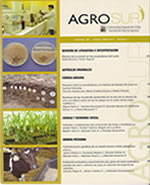Effect of an anabolic growth-stimulating implant on the productive and economic response of steers of three breeds
Main Article Content
Abstract
The use of anabolic growth-promoting implants (AGPI) is an extensive practice in the beef cattle industry in many countries around the world. However, implant technology has evolved in the last 15 years as well as animal genetics. This study aimed to assess the economic and productive response to AGPI in steers of three breeds. A total of 198 steers of Chilean Red Friesian, Holstein, and beef crossbred breeds were used with initial body weights of 419 ± 3.5 kg; 439 ± 3.4 kg; and 412 ± 3.4 kg, respectively. Half of the animals within each breed (n= 33) were randomly assigned to receive an AGPI. Data on animal performance and the prices paid for the steers were collected and analysed considering a 2x3 factorial treatment structure (AGPI and breed). There was an interaction between breed and AGPI (P < 0.005) for average daily weight gain (ADG). The Chilean Red Friesian breed had the highest ADG with no differences due to AGPI (1.32 vs. 1.33 kg d-1). Holstein steers increased ADG when used AGPI (1.23 vs. 0.79 kg d-1) as well as beef crossbred steers (1.12 vs. 0.86 kg d-1). The highest incomes due to AGPI were observed in Holstein steers (1.7 times than beef crossbred steers). Likewise, the return of the investment over the AGPI was also higher for Holstein steers (26 times) over beef crossbred steers (15 times). We conclude that ADG and marginal revenues were dependent on the combination of AGPI and breed. Implanted steers except for those of the Chilean Red Friesian breed presented a better economic and productive response.

